Strategic Plan: Development and Implementation Report
VerifiedAdded on 2023/01/10
|12
|2549
|97
Report
AI Summary
This report delves into the multifaceted world of strategic planning, examining its core components and practical applications. It explores the impact of legislation, regulations, and codes of practice on an organization's strategic plan, providing real-world examples of their effects. The report also addresses intellectual property risks, business responsibilities, and effective risk management strategies. Furthermore, it identifies and explains various strategic plan risks, such as competitive pressure and regulatory changes, and outlines risk management strategies to mitigate these challenges. The report includes research information relevant for inclusion in a strategic plan, along with a comparison of PEST and SWOT methodologies. It also outlines internal and external information sources for gathering essential data. Moreover, the report defines organizational values, offering techniques for their development and integration. Finally, it discusses how to confirm the relevance and support of an organization's mission, vision, and values.
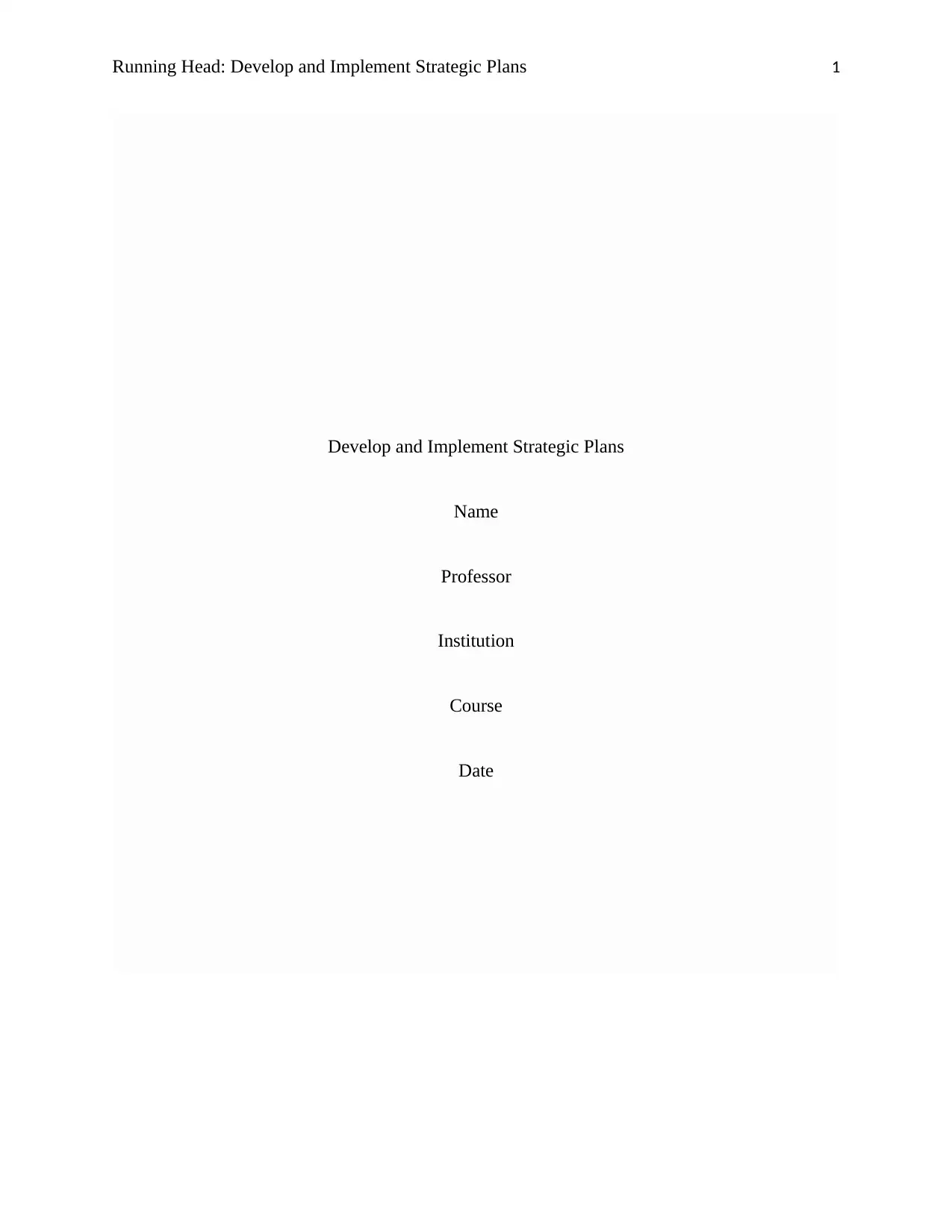
Running Head: Develop and Implement Strategic Plans 1
Develop and Implement Strategic Plans
Name
Professor
Institution
Course
Date
Develop and Implement Strategic Plans
Name
Professor
Institution
Course
Date
Paraphrase This Document
Need a fresh take? Get an instant paraphrase of this document with our AI Paraphraser
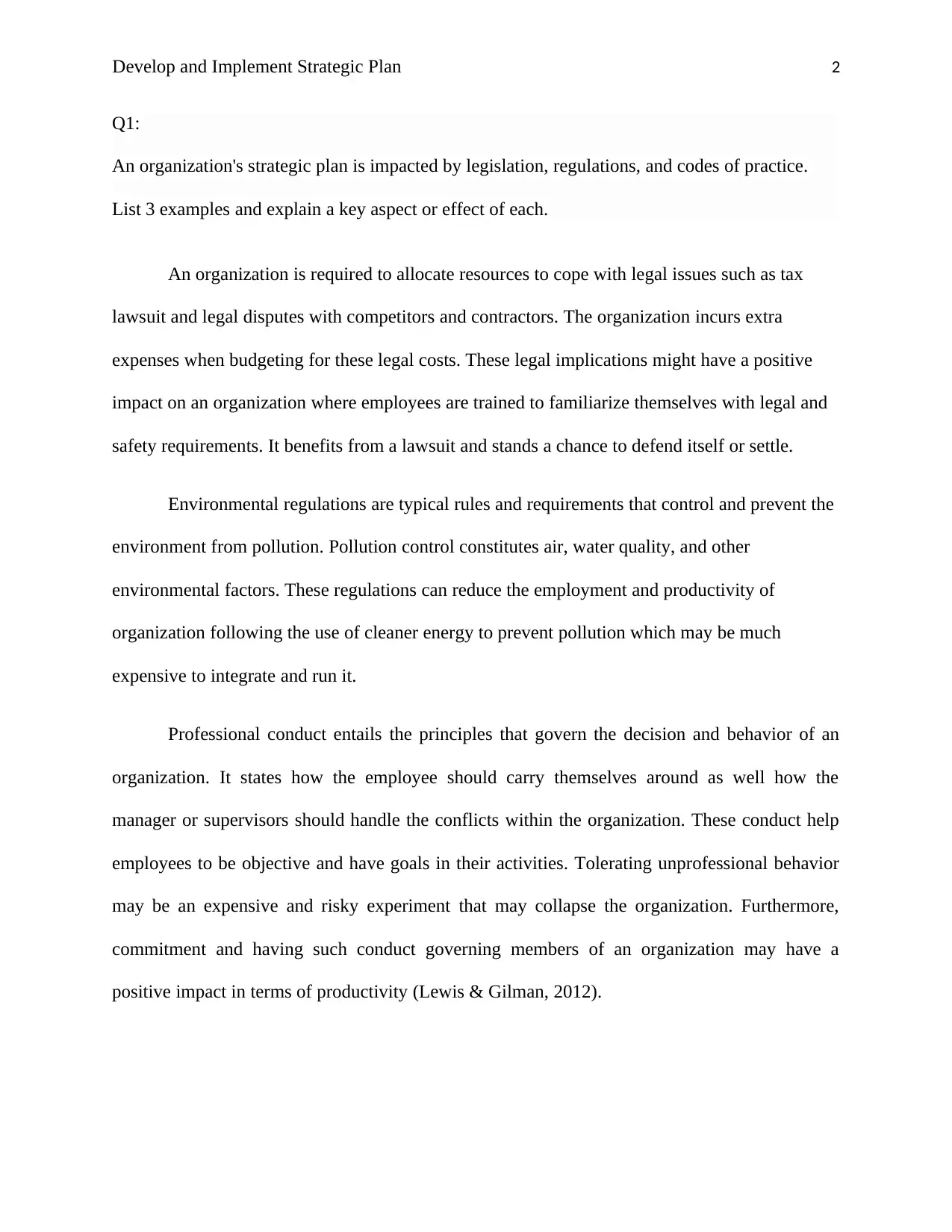
Develop and Implement Strategic Plan 2
Q1:
An organization's strategic plan is impacted by legislation, regulations, and codes of practice.
List 3 examples and explain a key aspect or effect of each.
An organization is required to allocate resources to cope with legal issues such as tax
lawsuit and legal disputes with competitors and contractors. The organization incurs extra
expenses when budgeting for these legal costs. These legal implications might have a positive
impact on an organization where employees are trained to familiarize themselves with legal and
safety requirements. It benefits from a lawsuit and stands a chance to defend itself or settle.
Environmental regulations are typical rules and requirements that control and prevent the
environment from pollution. Pollution control constitutes air, water quality, and other
environmental factors. These regulations can reduce the employment and productivity of
organization following the use of cleaner energy to prevent pollution which may be much
expensive to integrate and run it.
Professional conduct entails the principles that govern the decision and behavior of an
organization. It states how the employee should carry themselves around as well how the
manager or supervisors should handle the conflicts within the organization. These conduct help
employees to be objective and have goals in their activities. Tolerating unprofessional behavior
may be an expensive and risky experiment that may collapse the organization. Furthermore,
commitment and having such conduct governing members of an organization may have a
positive impact in terms of productivity (Lewis & Gilman, 2012).
Q1:
An organization's strategic plan is impacted by legislation, regulations, and codes of practice.
List 3 examples and explain a key aspect or effect of each.
An organization is required to allocate resources to cope with legal issues such as tax
lawsuit and legal disputes with competitors and contractors. The organization incurs extra
expenses when budgeting for these legal costs. These legal implications might have a positive
impact on an organization where employees are trained to familiarize themselves with legal and
safety requirements. It benefits from a lawsuit and stands a chance to defend itself or settle.
Environmental regulations are typical rules and requirements that control and prevent the
environment from pollution. Pollution control constitutes air, water quality, and other
environmental factors. These regulations can reduce the employment and productivity of
organization following the use of cleaner energy to prevent pollution which may be much
expensive to integrate and run it.
Professional conduct entails the principles that govern the decision and behavior of an
organization. It states how the employee should carry themselves around as well how the
manager or supervisors should handle the conflicts within the organization. These conduct help
employees to be objective and have goals in their activities. Tolerating unprofessional behavior
may be an expensive and risky experiment that may collapse the organization. Furthermore,
commitment and having such conduct governing members of an organization may have a
positive impact in terms of productivity (Lewis & Gilman, 2012).
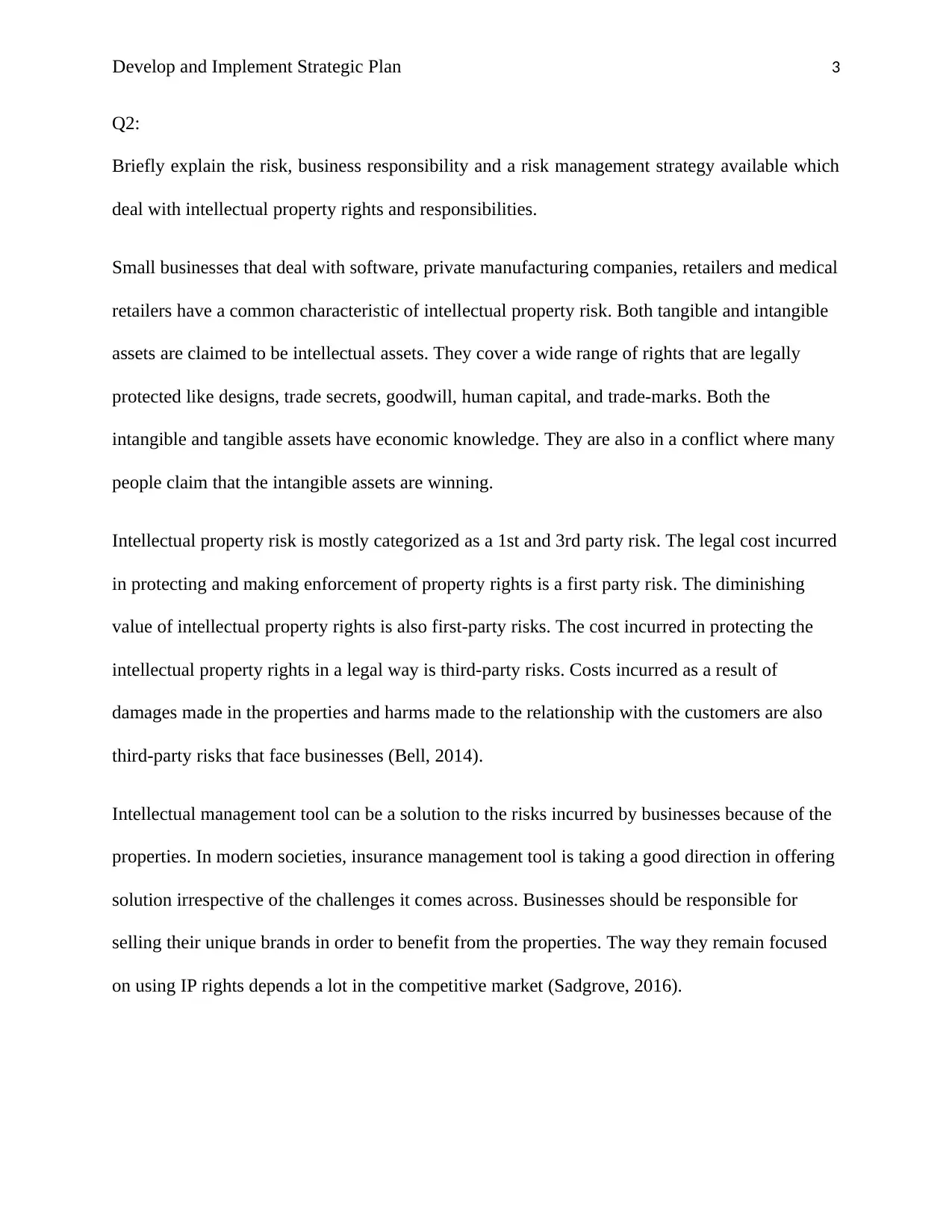
Develop and Implement Strategic Plan 3
Q2:
Briefly explain the risk, business responsibility and a risk management strategy available which
deal with intellectual property rights and responsibilities.
Small businesses that deal with software, private manufacturing companies, retailers and medical
retailers have a common characteristic of intellectual property risk. Both tangible and intangible
assets are claimed to be intellectual assets. They cover a wide range of rights that are legally
protected like designs, trade secrets, goodwill, human capital, and trade-marks. Both the
intangible and tangible assets have economic knowledge. They are also in a conflict where many
people claim that the intangible assets are winning.
Intellectual property risk is mostly categorized as a 1st and 3rd party risk. The legal cost incurred
in protecting and making enforcement of property rights is a first party risk. The diminishing
value of intellectual property rights is also first-party risks. The cost incurred in protecting the
intellectual property rights in a legal way is third-party risks. Costs incurred as a result of
damages made in the properties and harms made to the relationship with the customers are also
third-party risks that face businesses (Bell, 2014).
Intellectual management tool can be a solution to the risks incurred by businesses because of the
properties. In modern societies, insurance management tool is taking a good direction in offering
solution irrespective of the challenges it comes across. Businesses should be responsible for
selling their unique brands in order to benefit from the properties. The way they remain focused
on using IP rights depends a lot in the competitive market (Sadgrove, 2016).
Q2:
Briefly explain the risk, business responsibility and a risk management strategy available which
deal with intellectual property rights and responsibilities.
Small businesses that deal with software, private manufacturing companies, retailers and medical
retailers have a common characteristic of intellectual property risk. Both tangible and intangible
assets are claimed to be intellectual assets. They cover a wide range of rights that are legally
protected like designs, trade secrets, goodwill, human capital, and trade-marks. Both the
intangible and tangible assets have economic knowledge. They are also in a conflict where many
people claim that the intangible assets are winning.
Intellectual property risk is mostly categorized as a 1st and 3rd party risk. The legal cost incurred
in protecting and making enforcement of property rights is a first party risk. The diminishing
value of intellectual property rights is also first-party risks. The cost incurred in protecting the
intellectual property rights in a legal way is third-party risks. Costs incurred as a result of
damages made in the properties and harms made to the relationship with the customers are also
third-party risks that face businesses (Bell, 2014).
Intellectual management tool can be a solution to the risks incurred by businesses because of the
properties. In modern societies, insurance management tool is taking a good direction in offering
solution irrespective of the challenges it comes across. Businesses should be responsible for
selling their unique brands in order to benefit from the properties. The way they remain focused
on using IP rights depends a lot in the competitive market (Sadgrove, 2016).
⊘ This is a preview!⊘
Do you want full access?
Subscribe today to unlock all pages.

Trusted by 1+ million students worldwide
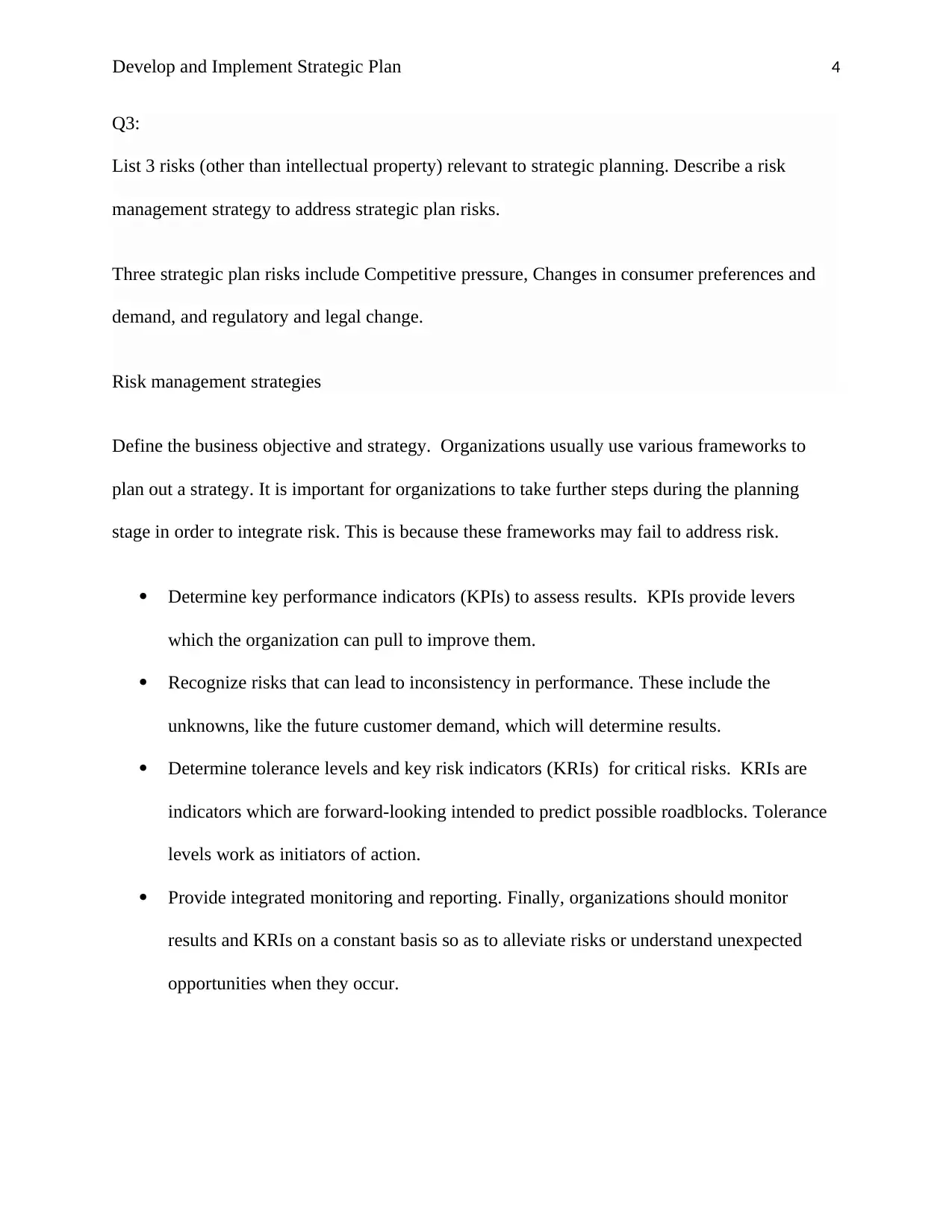
Develop and Implement Strategic Plan 4
Q3:
List 3 risks (other than intellectual property) relevant to strategic planning. Describe a risk
management strategy to address strategic plan risks.
Three strategic plan risks include Competitive pressure, Changes in consumer preferences and
demand, and regulatory and legal change.
Risk management strategies
Define the business objective and strategy. Organizations usually use various frameworks to
plan out a strategy. It is important for organizations to take further steps during the planning
stage in order to integrate risk. This is because these frameworks may fail to address risk.
Determine key performance indicators (KPIs) to assess results. KPIs provide levers
which the organization can pull to improve them.
Recognize risks that can lead to inconsistency in performance. These include the
unknowns, like the future customer demand, which will determine results.
Determine tolerance levels and key risk indicators (KRIs) for critical risks. KRIs are
indicators which are forward-looking intended to predict possible roadblocks. Tolerance
levels work as initiators of action.
Provide integrated monitoring and reporting. Finally, organizations should monitor
results and KRIs on a constant basis so as to alleviate risks or understand unexpected
opportunities when they occur.
Q3:
List 3 risks (other than intellectual property) relevant to strategic planning. Describe a risk
management strategy to address strategic plan risks.
Three strategic plan risks include Competitive pressure, Changes in consumer preferences and
demand, and regulatory and legal change.
Risk management strategies
Define the business objective and strategy. Organizations usually use various frameworks to
plan out a strategy. It is important for organizations to take further steps during the planning
stage in order to integrate risk. This is because these frameworks may fail to address risk.
Determine key performance indicators (KPIs) to assess results. KPIs provide levers
which the organization can pull to improve them.
Recognize risks that can lead to inconsistency in performance. These include the
unknowns, like the future customer demand, which will determine results.
Determine tolerance levels and key risk indicators (KRIs) for critical risks. KRIs are
indicators which are forward-looking intended to predict possible roadblocks. Tolerance
levels work as initiators of action.
Provide integrated monitoring and reporting. Finally, organizations should monitor
results and KRIs on a constant basis so as to alleviate risks or understand unexpected
opportunities when they occur.
Paraphrase This Document
Need a fresh take? Get an instant paraphrase of this document with our AI Paraphraser
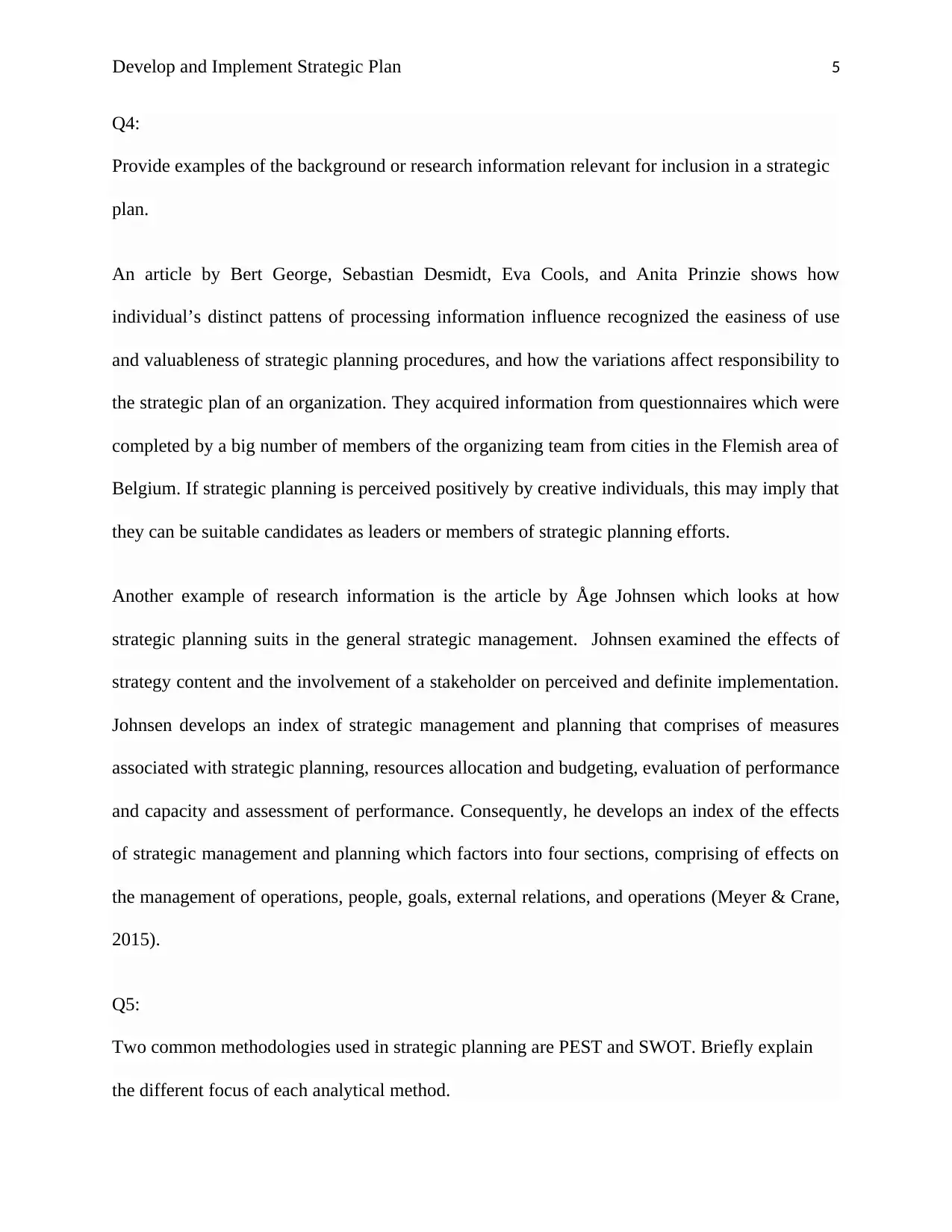
Develop and Implement Strategic Plan 5
Q4:
Provide examples of the background or research information relevant for inclusion in a strategic
plan.
An article by Bert George, Sebastian Desmidt, Eva Cools, and Anita Prinzie shows how
individual’s distinct pattens of processing information influence recognized the easiness of use
and valuableness of strategic planning procedures, and how the variations affect responsibility to
the strategic plan of an organization. They acquired information from questionnaires which were
completed by a big number of members of the organizing team from cities in the Flemish area of
Belgium. If strategic planning is perceived positively by creative individuals, this may imply that
they can be suitable candidates as leaders or members of strategic planning efforts.
Another example of research information is the article by Åge Johnsen which looks at how
strategic planning suits in the general strategic management. Johnsen examined the effects of
strategy content and the involvement of a stakeholder on perceived and definite implementation.
Johnsen develops an index of strategic management and planning that comprises of measures
associated with strategic planning, resources allocation and budgeting, evaluation of performance
and capacity and assessment of performance. Consequently, he develops an index of the effects
of strategic management and planning which factors into four sections, comprising of effects on
the management of operations, people, goals, external relations, and operations (Meyer & Crane,
2015).
Q5:
Two common methodologies used in strategic planning are PEST and SWOT. Briefly explain
the different focus of each analytical method.
Q4:
Provide examples of the background or research information relevant for inclusion in a strategic
plan.
An article by Bert George, Sebastian Desmidt, Eva Cools, and Anita Prinzie shows how
individual’s distinct pattens of processing information influence recognized the easiness of use
and valuableness of strategic planning procedures, and how the variations affect responsibility to
the strategic plan of an organization. They acquired information from questionnaires which were
completed by a big number of members of the organizing team from cities in the Flemish area of
Belgium. If strategic planning is perceived positively by creative individuals, this may imply that
they can be suitable candidates as leaders or members of strategic planning efforts.
Another example of research information is the article by Åge Johnsen which looks at how
strategic planning suits in the general strategic management. Johnsen examined the effects of
strategy content and the involvement of a stakeholder on perceived and definite implementation.
Johnsen develops an index of strategic management and planning that comprises of measures
associated with strategic planning, resources allocation and budgeting, evaluation of performance
and capacity and assessment of performance. Consequently, he develops an index of the effects
of strategic management and planning which factors into four sections, comprising of effects on
the management of operations, people, goals, external relations, and operations (Meyer & Crane,
2015).
Q5:
Two common methodologies used in strategic planning are PEST and SWOT. Briefly explain
the different focus of each analytical method.
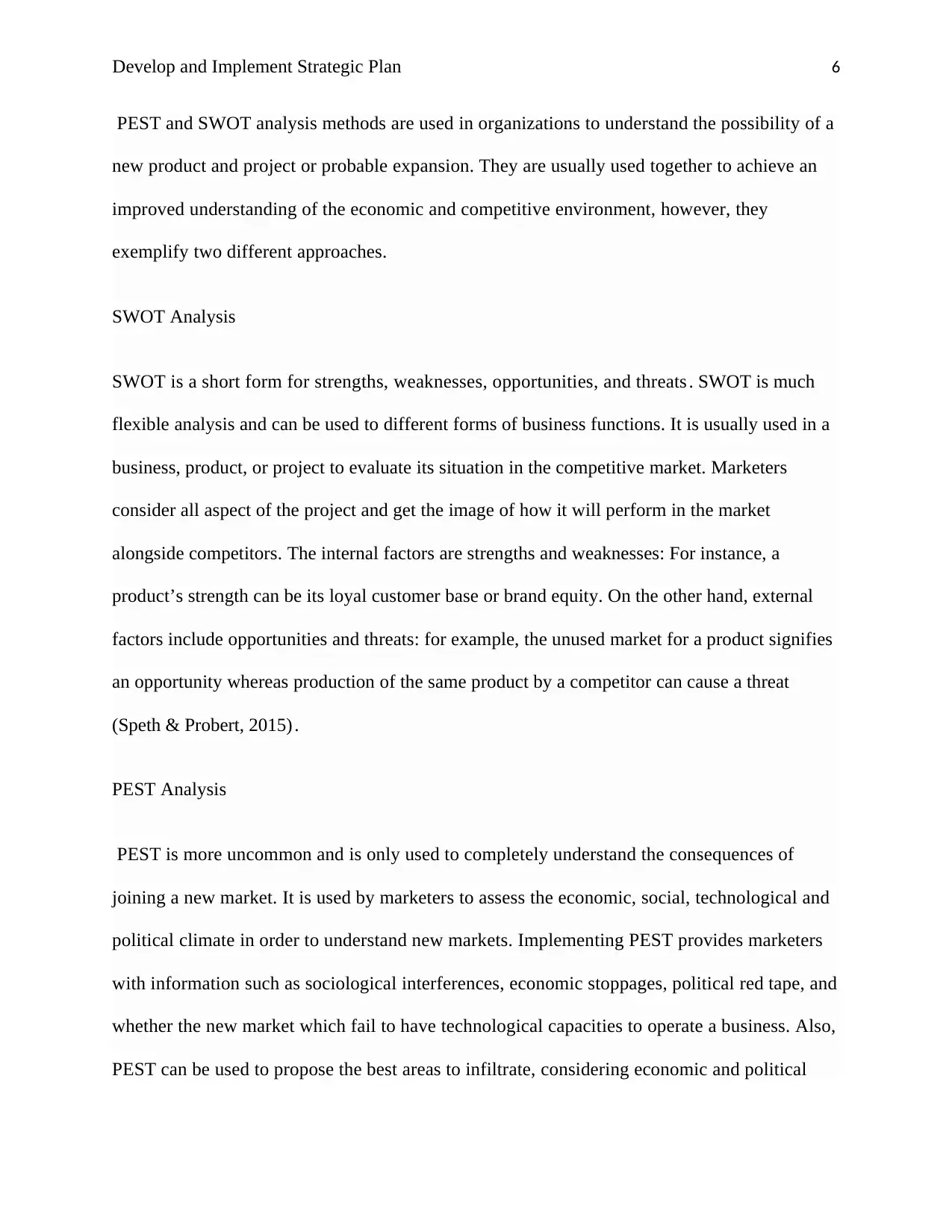
Develop and Implement Strategic Plan 6
PEST and SWOT analysis methods are used in organizations to understand the possibility of a
new product and project or probable expansion. They are usually used together to achieve an
improved understanding of the economic and competitive environment, however, they
exemplify two different approaches.
SWOT Analysis
SWOT is a short form for strengths, weaknesses, opportunities, and threats. SWOT is much
flexible analysis and can be used to different forms of business functions. It is usually used in a
business, product, or project to evaluate its situation in the competitive market. Marketers
consider all aspect of the project and get the image of how it will perform in the market
alongside competitors. The internal factors are strengths and weaknesses: For instance, a
product’s strength can be its loyal customer base or brand equity. On the other hand, external
factors include opportunities and threats: for example, the unused market for a product signifies
an opportunity whereas production of the same product by a competitor can cause a threat
(Speth & Probert, 2015) .
PEST Analysis
PEST is more uncommon and is only used to completely understand the consequences of
joining a new market. It is used by marketers to assess the economic, social, technological and
political climate in order to understand new markets. Implementing PEST provides marketers
with information such as sociological interferences, economic stoppages, political red tape, and
whether the new market which fail to have technological capacities to operate a business. Also,
PEST can be used to propose the best areas to infiltrate, considering economic and political
PEST and SWOT analysis methods are used in organizations to understand the possibility of a
new product and project or probable expansion. They are usually used together to achieve an
improved understanding of the economic and competitive environment, however, they
exemplify two different approaches.
SWOT Analysis
SWOT is a short form for strengths, weaknesses, opportunities, and threats. SWOT is much
flexible analysis and can be used to different forms of business functions. It is usually used in a
business, product, or project to evaluate its situation in the competitive market. Marketers
consider all aspect of the project and get the image of how it will perform in the market
alongside competitors. The internal factors are strengths and weaknesses: For instance, a
product’s strength can be its loyal customer base or brand equity. On the other hand, external
factors include opportunities and threats: for example, the unused market for a product signifies
an opportunity whereas production of the same product by a competitor can cause a threat
(Speth & Probert, 2015) .
PEST Analysis
PEST is more uncommon and is only used to completely understand the consequences of
joining a new market. It is used by marketers to assess the economic, social, technological and
political climate in order to understand new markets. Implementing PEST provides marketers
with information such as sociological interferences, economic stoppages, political red tape, and
whether the new market which fail to have technological capacities to operate a business. Also,
PEST can be used to propose the best areas to infiltrate, considering economic and political
⊘ This is a preview!⊘
Do you want full access?
Subscribe today to unlock all pages.

Trusted by 1+ million students worldwide
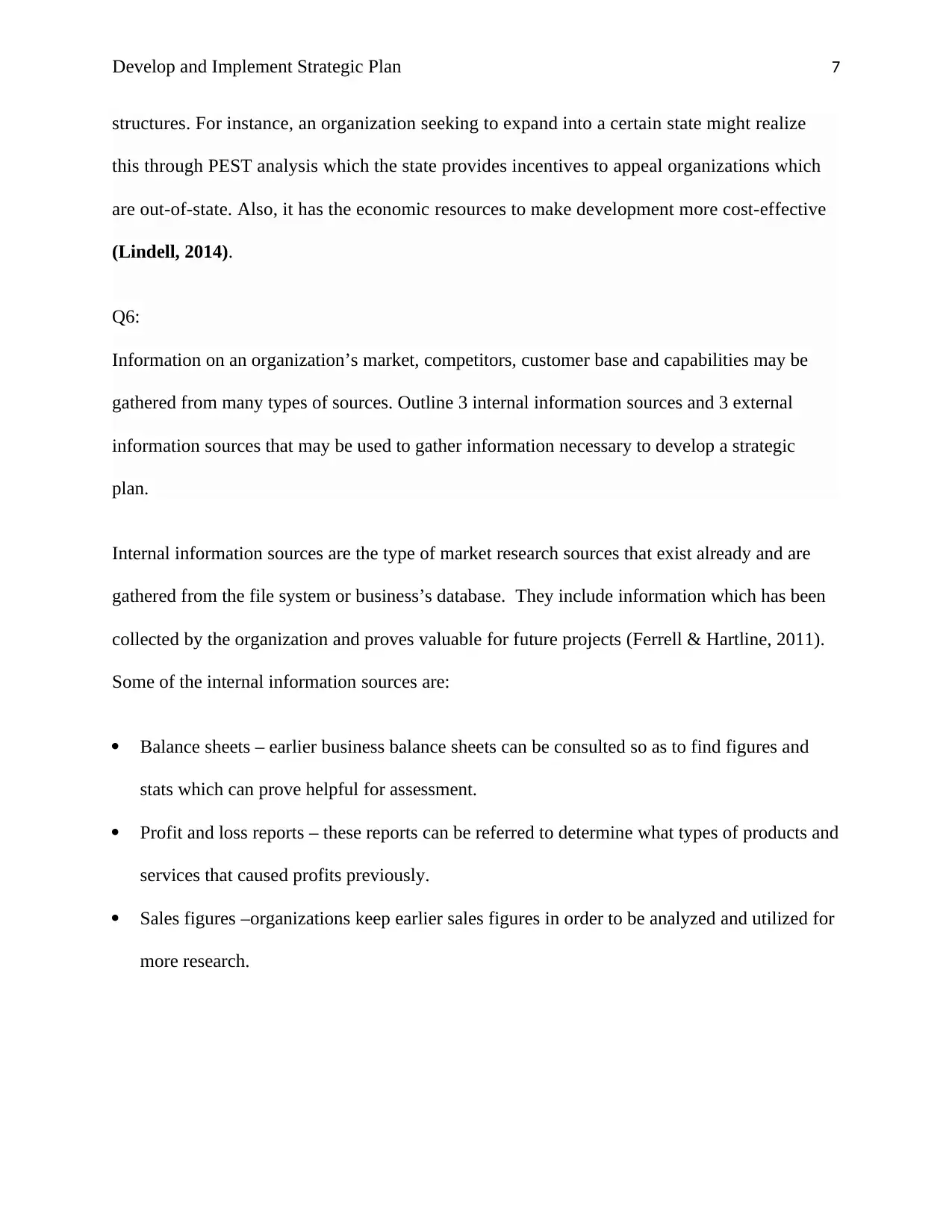
Develop and Implement Strategic Plan 7
structures. For instance, an organization seeking to expand into a certain state might realize
this through PEST analysis which the state provides incentives to appeal organizations which
are out-of-state. Also, it has the economic resources to make development more cost-effective
(Lindell, 2014).
Q6:
Information on an organization’s market, competitors, customer base and capabilities may be
gathered from many types of sources. Outline 3 internal information sources and 3 external
information sources that may be used to gather information necessary to develop a strategic
plan.
Internal information sources are the type of market research sources that exist already and are
gathered from the file system or business’s database. They include information which has been
collected by the organization and proves valuable for future projects (Ferrell & Hartline, 2011).
Some of the internal information sources are:
Balance sheets – earlier business balance sheets can be consulted so as to find figures and
stats which can prove helpful for assessment.
Profit and loss reports – these reports can be referred to determine what types of products and
services that caused profits previously.
Sales figures –organizations keep earlier sales figures in order to be analyzed and utilized for
more research.
structures. For instance, an organization seeking to expand into a certain state might realize
this through PEST analysis which the state provides incentives to appeal organizations which
are out-of-state. Also, it has the economic resources to make development more cost-effective
(Lindell, 2014).
Q6:
Information on an organization’s market, competitors, customer base and capabilities may be
gathered from many types of sources. Outline 3 internal information sources and 3 external
information sources that may be used to gather information necessary to develop a strategic
plan.
Internal information sources are the type of market research sources that exist already and are
gathered from the file system or business’s database. They include information which has been
collected by the organization and proves valuable for future projects (Ferrell & Hartline, 2011).
Some of the internal information sources are:
Balance sheets – earlier business balance sheets can be consulted so as to find figures and
stats which can prove helpful for assessment.
Profit and loss reports – these reports can be referred to determine what types of products and
services that caused profits previously.
Sales figures –organizations keep earlier sales figures in order to be analyzed and utilized for
more research.
Paraphrase This Document
Need a fresh take? Get an instant paraphrase of this document with our AI Paraphraser
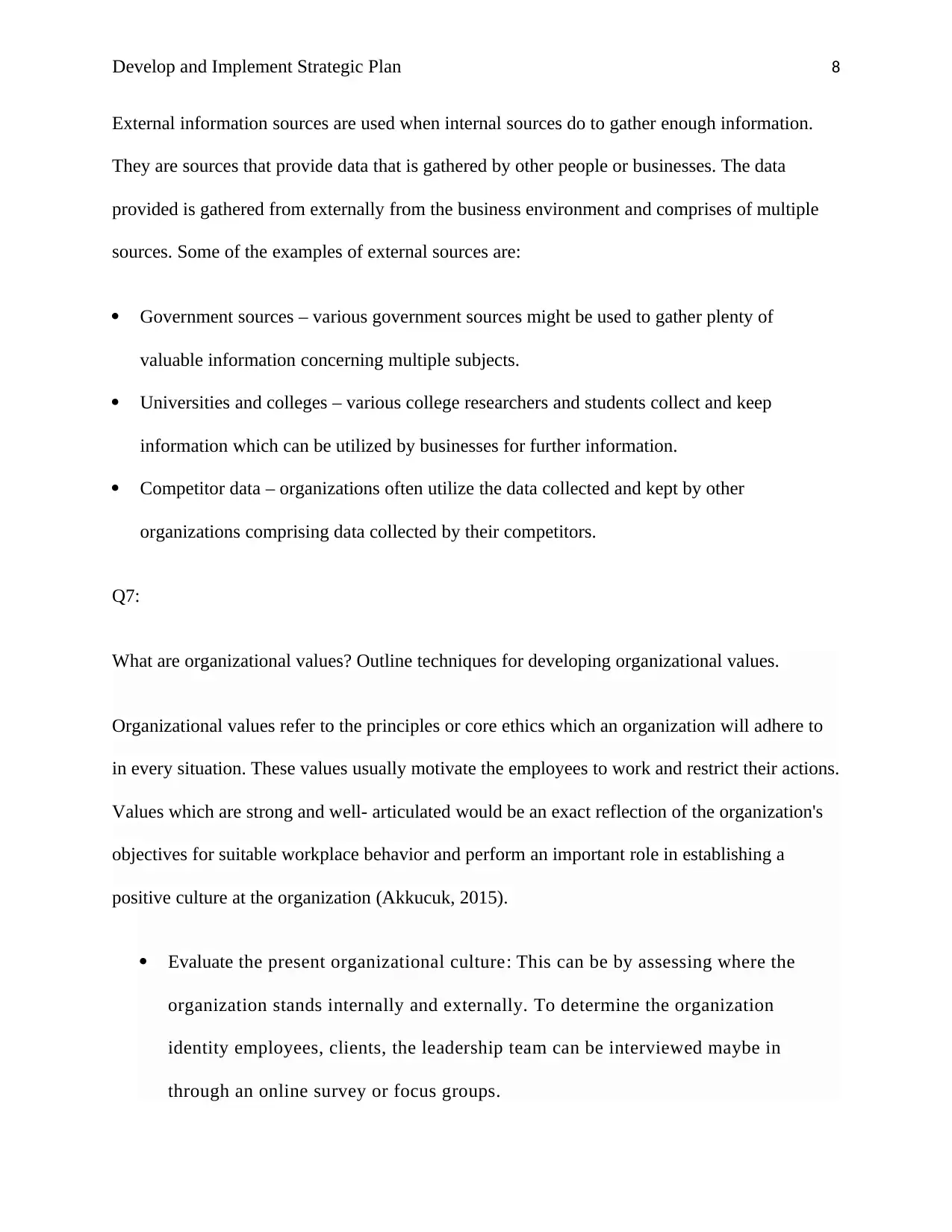
Develop and Implement Strategic Plan 8
External information sources are used when internal sources do to gather enough information.
They are sources that provide data that is gathered by other people or businesses. The data
provided is gathered from externally from the business environment and comprises of multiple
sources. Some of the examples of external sources are:
Government sources – various government sources might be used to gather plenty of
valuable information concerning multiple subjects.
Universities and colleges – various college researchers and students collect and keep
information which can be utilized by businesses for further information.
Competitor data – organizations often utilize the data collected and kept by other
organizations comprising data collected by their competitors.
Q7:
What are organizational values? Outline techniques for developing organizational values.
Organizational values refer to the principles or core ethics which an organization will adhere to
in every situation. These values usually motivate the employees to work and restrict their actions.
Values which are strong and well- articulated would be an exact reflection of the organization's
objectives for suitable workplace behavior and perform an important role in establishing a
positive culture at the organization (Akkucuk, 2015).
Evaluate the present organizational culture: This can be by assessing where the
organization stands internally and externally. To determine the organization
identity employees, clients, the leadership team can be interviewed maybe in
through an online survey or focus groups.
External information sources are used when internal sources do to gather enough information.
They are sources that provide data that is gathered by other people or businesses. The data
provided is gathered from externally from the business environment and comprises of multiple
sources. Some of the examples of external sources are:
Government sources – various government sources might be used to gather plenty of
valuable information concerning multiple subjects.
Universities and colleges – various college researchers and students collect and keep
information which can be utilized by businesses for further information.
Competitor data – organizations often utilize the data collected and kept by other
organizations comprising data collected by their competitors.
Q7:
What are organizational values? Outline techniques for developing organizational values.
Organizational values refer to the principles or core ethics which an organization will adhere to
in every situation. These values usually motivate the employees to work and restrict their actions.
Values which are strong and well- articulated would be an exact reflection of the organization's
objectives for suitable workplace behavior and perform an important role in establishing a
positive culture at the organization (Akkucuk, 2015).
Evaluate the present organizational culture: This can be by assessing where the
organization stands internally and externally. To determine the organization
identity employees, clients, the leadership team can be interviewed maybe in
through an online survey or focus groups.
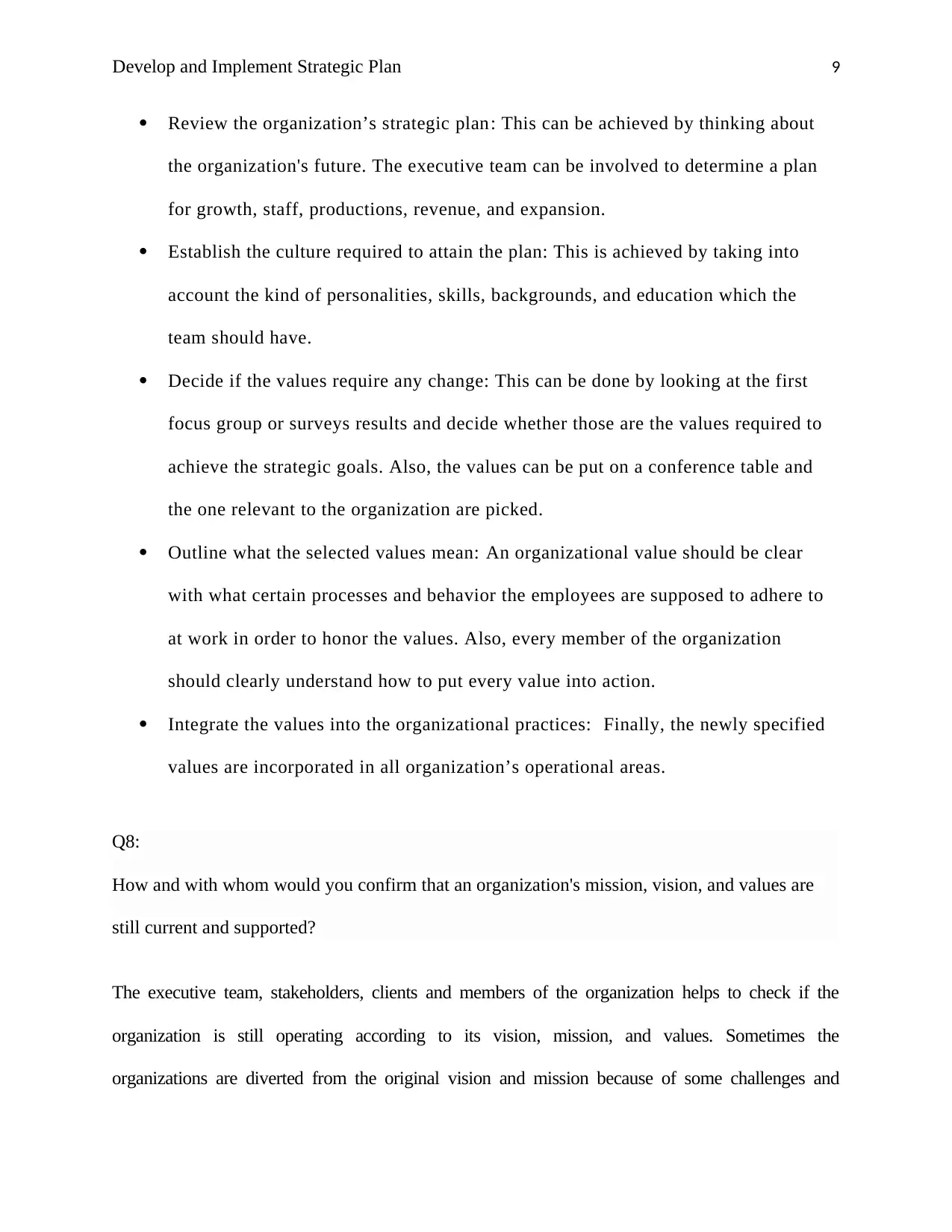
Develop and Implement Strategic Plan 9
Review the organization’s strategic plan: This can be achieved by thinking about
the organization's future. The executive team can be involved to determine a plan
for growth, staff, productions, revenue, and expansion.
Establish the culture required to attain the plan: This is achieved by taking into
account the kind of personalities, skills, backgrounds, and education which the
team should have.
Decide if the values require any change: This can be done by looking at the first
focus group or surveys results and decide whether those are the values required to
achieve the strategic goals. Also, the values can be put on a conference table and
the one relevant to the organization are picked.
Outline what the selected values mean: An organizational value should be clear
with what certain processes and behavior the employees are supposed to adhere to
at work in order to honor the values. Also, every member of the organization
should clearly understand how to put every value into action.
Integrate the values into the organizational practices: Finally, the newly specified
values are incorporated in all organization’s operational areas.
Q8:
How and with whom would you confirm that an organization's mission, vision, and values are
still current and supported?
The executive team, stakeholders, clients and members of the organization helps to check if the
organization is still operating according to its vision, mission, and values. Sometimes the
organizations are diverted from the original vision and mission because of some challenges and
Review the organization’s strategic plan: This can be achieved by thinking about
the organization's future. The executive team can be involved to determine a plan
for growth, staff, productions, revenue, and expansion.
Establish the culture required to attain the plan: This is achieved by taking into
account the kind of personalities, skills, backgrounds, and education which the
team should have.
Decide if the values require any change: This can be done by looking at the first
focus group or surveys results and decide whether those are the values required to
achieve the strategic goals. Also, the values can be put on a conference table and
the one relevant to the organization are picked.
Outline what the selected values mean: An organizational value should be clear
with what certain processes and behavior the employees are supposed to adhere to
at work in order to honor the values. Also, every member of the organization
should clearly understand how to put every value into action.
Integrate the values into the organizational practices: Finally, the newly specified
values are incorporated in all organization’s operational areas.
Q8:
How and with whom would you confirm that an organization's mission, vision, and values are
still current and supported?
The executive team, stakeholders, clients and members of the organization helps to check if the
organization is still operating according to its vision, mission, and values. Sometimes the
organizations are diverted from the original vision and mission because of some challenges and
⊘ This is a preview!⊘
Do you want full access?
Subscribe today to unlock all pages.

Trusted by 1+ million students worldwide
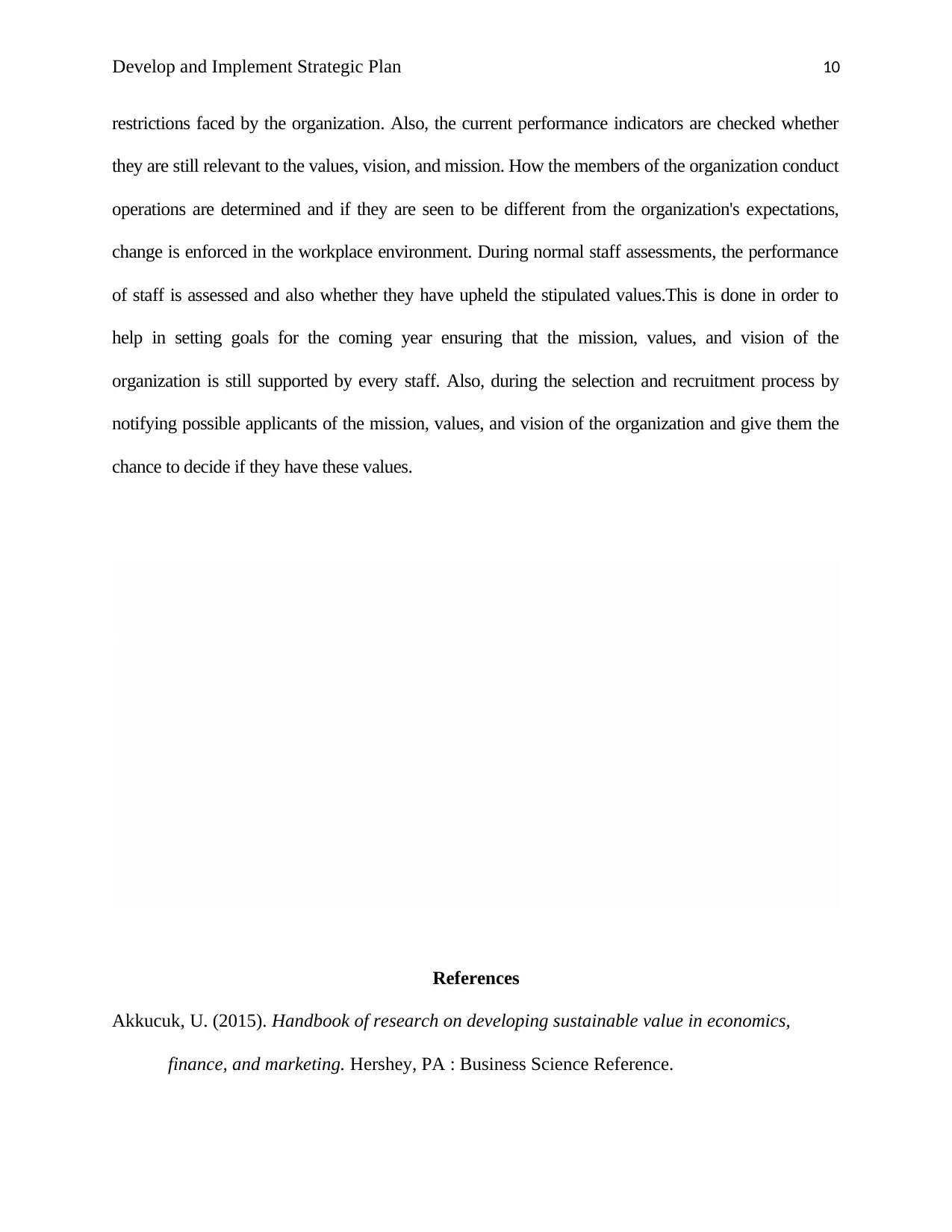
Develop and Implement Strategic Plan 10
restrictions faced by the organization. Also, the current performance indicators are checked whether
they are still relevant to the values, vision, and mission. How the members of the organization conduct
operations are determined and if they are seen to be different from the organization's expectations,
change is enforced in the workplace environment. During normal staff assessments, the performance
of staff is assessed and also whether they have upheld the stipulated values.This is done in order to
help in setting goals for the coming year ensuring that the mission, values, and vision of the
organization is still supported by every staff. Also, during the selection and recruitment process by
notifying possible applicants of the mission, values, and vision of the organization and give them the
chance to decide if they have these values.
References
Akkucuk, U. (2015). Handbook of research on developing sustainable value in economics,
finance, and marketing. Hershey, PA : Business Science Reference.
restrictions faced by the organization. Also, the current performance indicators are checked whether
they are still relevant to the values, vision, and mission. How the members of the organization conduct
operations are determined and if they are seen to be different from the organization's expectations,
change is enforced in the workplace environment. During normal staff assessments, the performance
of staff is assessed and also whether they have upheld the stipulated values.This is done in order to
help in setting goals for the coming year ensuring that the mission, values, and vision of the
organization is still supported by every staff. Also, during the selection and recruitment process by
notifying possible applicants of the mission, values, and vision of the organization and give them the
chance to decide if they have these values.
References
Akkucuk, U. (2015). Handbook of research on developing sustainable value in economics,
finance, and marketing. Hershey, PA : Business Science Reference.
Paraphrase This Document
Need a fresh take? Get an instant paraphrase of this document with our AI Paraphraser
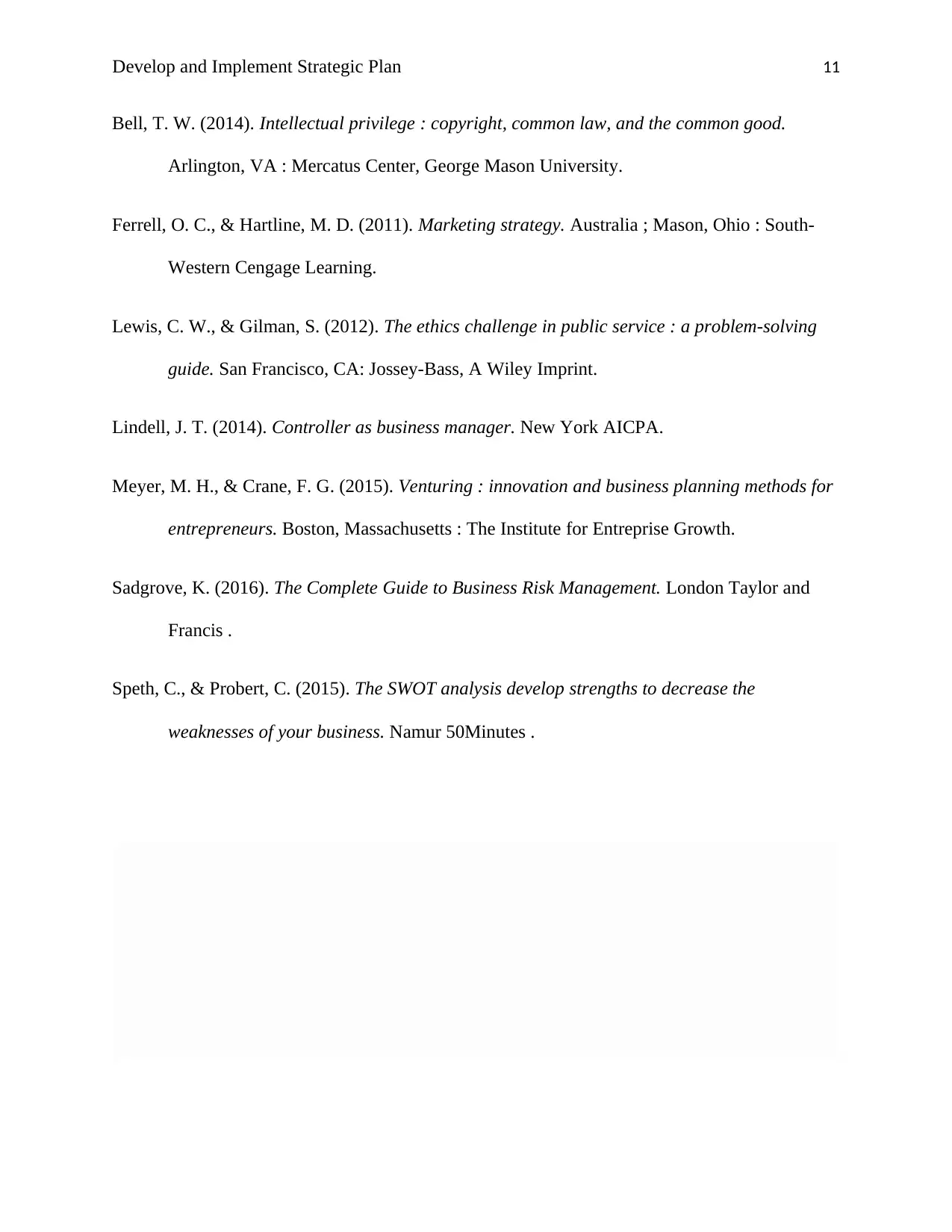
Develop and Implement Strategic Plan 11
Bell, T. W. (2014). Intellectual privilege : copyright, common law, and the common good.
Arlington, VA : Mercatus Center, George Mason University.
Ferrell, O. C., & Hartline, M. D. (2011). Marketing strategy. Australia ; Mason, Ohio : South-
Western Cengage Learning.
Lewis, C. W., & Gilman, S. (2012). The ethics challenge in public service : a problem-solving
guide. San Francisco, CA: Jossey-Bass, A Wiley Imprint.
Lindell, J. T. (2014). Controller as business manager. New York AICPA.
Meyer, M. H., & Crane, F. G. (2015). Venturing : innovation and business planning methods for
entrepreneurs. Boston, Massachusetts : The Institute for Entreprise Growth.
Sadgrove, K. (2016). The Complete Guide to Business Risk Management. London Taylor and
Francis .
Speth, C., & Probert, C. (2015). The SWOT analysis develop strengths to decrease the
weaknesses of your business. Namur 50Minutes .
Bell, T. W. (2014). Intellectual privilege : copyright, common law, and the common good.
Arlington, VA : Mercatus Center, George Mason University.
Ferrell, O. C., & Hartline, M. D. (2011). Marketing strategy. Australia ; Mason, Ohio : South-
Western Cengage Learning.
Lewis, C. W., & Gilman, S. (2012). The ethics challenge in public service : a problem-solving
guide. San Francisco, CA: Jossey-Bass, A Wiley Imprint.
Lindell, J. T. (2014). Controller as business manager. New York AICPA.
Meyer, M. H., & Crane, F. G. (2015). Venturing : innovation and business planning methods for
entrepreneurs. Boston, Massachusetts : The Institute for Entreprise Growth.
Sadgrove, K. (2016). The Complete Guide to Business Risk Management. London Taylor and
Francis .
Speth, C., & Probert, C. (2015). The SWOT analysis develop strengths to decrease the
weaknesses of your business. Namur 50Minutes .
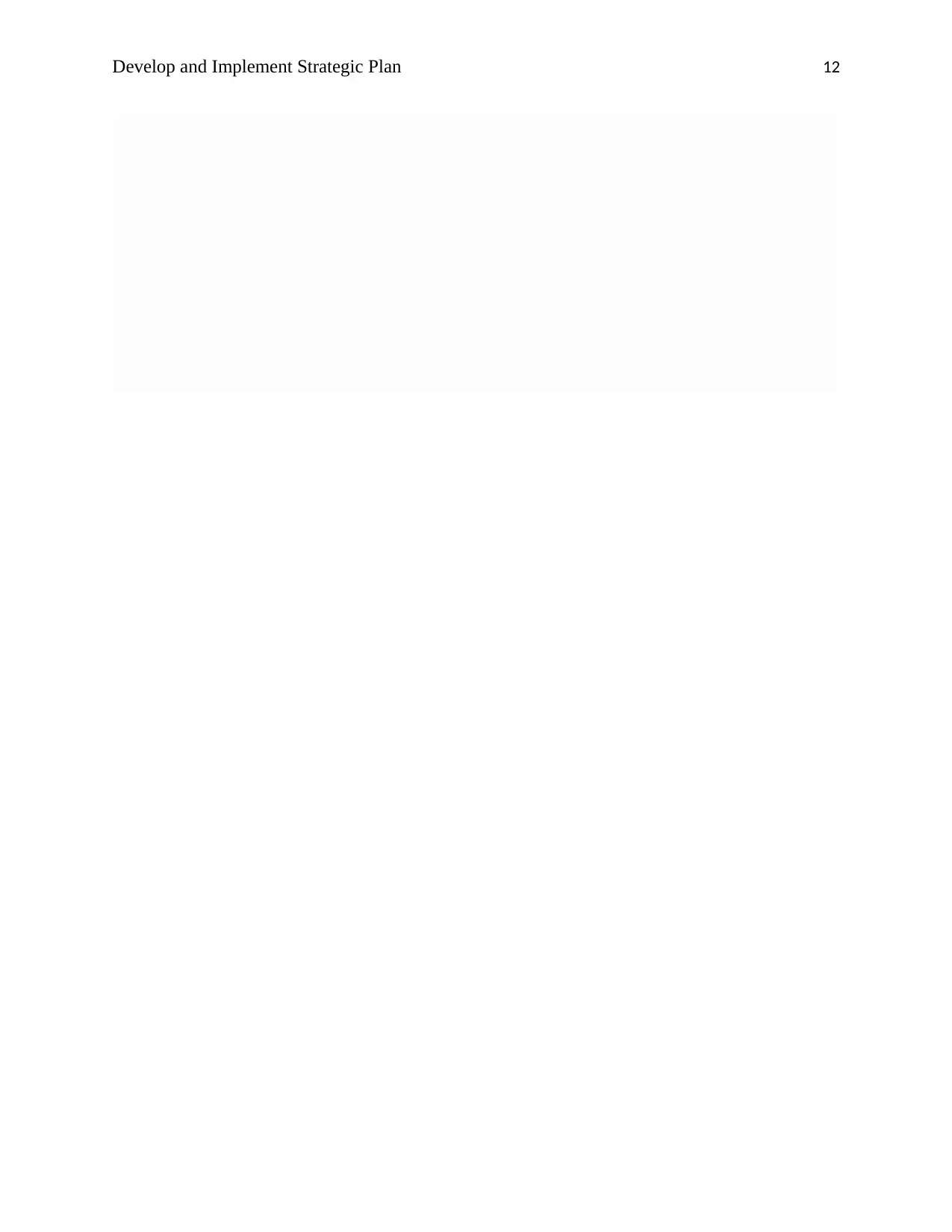
Develop and Implement Strategic Plan 12
⊘ This is a preview!⊘
Do you want full access?
Subscribe today to unlock all pages.

Trusted by 1+ million students worldwide
1 out of 12
Related Documents
Your All-in-One AI-Powered Toolkit for Academic Success.
+13062052269
info@desklib.com
Available 24*7 on WhatsApp / Email
![[object Object]](/_next/static/media/star-bottom.7253800d.svg)
Unlock your academic potential
Copyright © 2020–2025 A2Z Services. All Rights Reserved. Developed and managed by ZUCOL.





